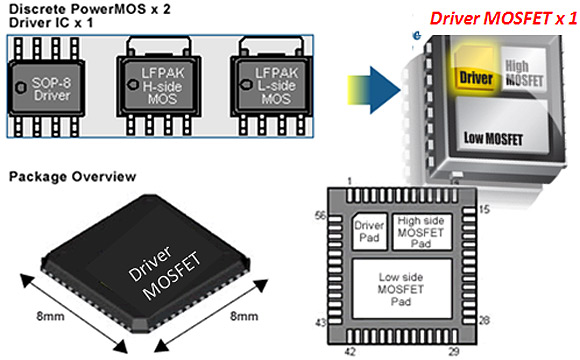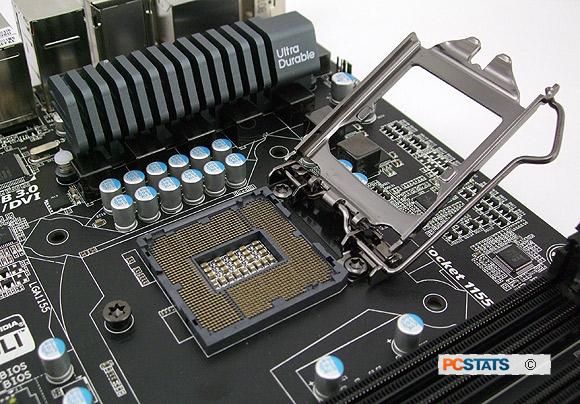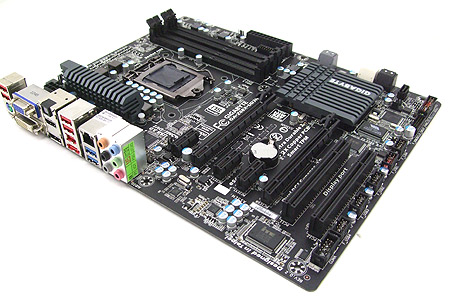
|
Socket 1155 motherboards like the Gigabyte GA-Z68X-UD3H-B3 which are built around it offer up a mainstream suite of capabilities and a kitchen sink full o'features. The board
supports 2nd Generation Intel Core i3/i5/i7 2xxx-series socket LGA1155
processors - these CPUs are based on the Intel 'SandyBridge'
architecture which includes an integrated graphics core on the CPU
die.
88% Rating: 
|
|
|
|
Home >
Reviews >
Motherboards >
Gigabyte GA-Z68X-UD3H-B3 |
|
|
System Power Draw and Final Conclusions
PCSTATS
measures total system power draw (watts) with the aid of an Extech 380803 AC
Power Analyzer and A-PFC compliant Seasonic SS-760KM power supply. The meter is placed
between the 120V AC outlet and the PC power supply and the computer stressed.
Total system power draw is recorded and compared to the PC's idle state.
| Total System Power Draw |
|
Idle
|
CPU
Loaded |
GFX
Loaded |
|
Intel Core i5
2500K
nVidia Geforce GTX470
|
85W
|
160W
|
245W
|
|
Intel Core i5
2500K
Intel HD 3000 IGP |
40W
|
113W
|
72W
|
|
|
(Idel @ desktop) |
(via Prime95) |
(via
3DM06) | |
Gigabyte's GA-Z68X-UD3H-B3 motherboard uses a 20-phase
power VRM design built around 'Driver MOSFETs' which combine the functions of a
driver, high MOSFET and low MOSFET into one small power-efficient board mounted
component. This integrated circuit improves power efficiency, reduces heat and
has a smaller footprint than previous circuit designs.

Judging
by the total system power draw measurements, running on CPU-IGP graphics is a
good way to save power! At idle the system draws 85W with videocard, 40W on IGP.
Likewise, CPU loaded power draw figures are 160W with VGA, 113W with IGP. The
big difference in power draw is evident with a run of 3DMark...
|

Gigabyte
VRM circuitry includes MOSFETS and LOW RDS Ferrite
Chokes.
|
All of
Gigabyte's Intel Z68 boards are VRD12 qualified and rely on an Intersil PWM
controller to control active power phases. This mobo uses a 4-layer PCB with
2oz. copper substrate that pulls double-duty as a board level heatsink for
surface mount devices.
Five "voltage control circuits" give overclockers
precise voltage control (as fine as 6.25mV) when adjusting CPU/chipset/memory
voltages in the BIOS. Gigabyte call this hardware Precision OV. This hardware
level voltage control circuit should help improve overclocking stability when
pushing voltages up, though as always your milage will vary.
Time to
wrap up this PCSTATS motherboard review up and tell you if the Gigabyte
GA-Z68X-UD3H-B3 is worth buying.
Final Thoughts: Time for a SandyBridge Upgrade?
 To sum up,
Gigabyte's GA-Z68X-UD3H-B3 motherboard is a well featured mainstream choice for
anyone who's outgrown the Intel P67 chipset and is currently looking to take
full advantage of their Intel SandyBridge processor. If you're frustrated by the
limits imposed by the P67 chipset or if you've ever wanted to set up
dual-screen IGP-based graphics, use Intel QuickSync and so forth, the Gigabyte
GA-Z68X-UD3H-B3 is board that makes this easily available. To sum up,
Gigabyte's GA-Z68X-UD3H-B3 motherboard is a well featured mainstream choice for
anyone who's outgrown the Intel P67 chipset and is currently looking to take
full advantage of their Intel SandyBridge processor. If you're frustrated by the
limits imposed by the P67 chipset or if you've ever wanted to set up
dual-screen IGP-based graphics, use Intel QuickSync and so forth, the Gigabyte
GA-Z68X-UD3H-B3 is board that makes this easily available.
In PCSTATS overclocking tests we manged to OC a Core i5 2500K
processor to 4.7GHz without touching voltage controls on the GA-Z68X-UD3H-B3
motherboard. The DX10.1 Intel HD 3000 IGP overclocked from 1100MHz to 1600MHz
with ease, as well. To be frank though, IGP overclocking speeds may sound
impressive but really it doesn't yield much in the way of tangible
gaming improvement. Get a PCI Express videocard, or two. The Gigabyte
GA-Z68X-UD3H-B3 supports both Crossfire and SLI, and with VIRTU you get the best
of both worlds.
The Gigabyte GA-Z68X-UD3H-B3 motherboard comes with an
onboard HDMI/DisplayPort/DVI-d/Analog VGA video outputs and most users will find
Intel's integrated graphics core satisfactory for everyday desktop work.
The IGP-CPU is faster than previous Intel IGP's as PCSTATS demonstrated, but
still very tame by graphics card standards. Next to AMD's A75/A8-3850 integrated
graphics, Intel's IGP is dead slow... however the transcoding
acceleration it brings forth is quite powerful. The GA-Z68X-UD3-B3 motherboard
notably features four USB 3.0 ports, four internal 6Gb/s SATA III ports, a pair
of PCI Express 2.0 x16 slots and accommodates DDR3 memory up to speeds of
DDR3-2133. On the down side the board comes with hardly anything - not even a
single USB 3.0 bracket!
PCSTATS touched on the in's and out's of Intel SRT already, suffice to say we have a positive
impression of what this technology can do for users. What's the bottom line? For
users considering an Intel socket LGA1155 computer build from scratch, at
~$164CDN, the Gigabyte GA-Z68X-UD3H-B3 is an economical
motherboard with a solid mainstream feature set that'll get you in the game.

Find out about this and many other reviews by joining the Weekly PCstats.com Newsletter today!
Catch all of PCSTATS latest reviews right here.
Related Articles
Here are a few other articles that you
might enjoy as well...
- Gigabyte GA-Z68XP-UD3-iSSD Intel Z68 Motherboard & Intel 20GB
SSD Review
- Gigabyte GA-Z68X-UD5-B3 Intel Z68 Motherboard Review
- Beginners Guide: Intel Smart Response Technology and Intel 311
Larson Creek SSD
- ASUS
P7P55D Premium Intel P55 Express Motherboard Review
- Intel
6-Series Chipset Recall - Sandy Bridge Intel P67 & H67 (v2.2)
- Biostar TH67XE Intel H67 Motherboard - FIRST
LOOK
|
